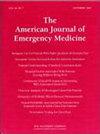慢性阻塞性肺病急性加重期使用高流量鼻插管与无创通气的比较
IF 2.7
3区 医学
Q1 EMERGENCY MEDICINE
引用次数: 0
摘要
目的我们研究了不同流速的高流量鼻插管(HFNC)与无创通气(NIV)相比,在慢性阻塞性肺疾病(COPD)急性加重患者中的有效性和安全性。NIV 组(n = 47)接受双水平气道正压治疗。HFNC-30 组(n = 44)和 HFNC-50 组(n = 46)分别接受流速为 30 和 50 L/min 的 HFNC 治疗。比较了各治疗组治疗前、治疗后 30 分钟、60 分钟和 120 分钟的人口统计学特征、临床特征和动脉血气参数。 结果这项研究连续纳入了 137 例慢性阻塞性肺疾病急性加重患者,其中男性 90 例,女性 47 例,平均年龄(68.1 ± 10.5)岁。共有 21 名患者(15.33%)插管,总死亡率为 10.2%。NIV 组、HFNC-30 组和 HFNC-50 组入院时的平均 PaCO2 水平分别为(64.69 ± 10.81)、(61.51 ± 9.03)和(62.29 ± 9.87),未观察到显著差异(p = 0.372)。在 30 分钟、60 分钟和 120 分钟时,所有治疗组的平均 PaCO2 均明显下降(均为 0.05)。然而,与 NIV 组相比,HFNC-30 组在 60 分钟时的ΔPaCO2 明显更高(p = 0.042)。此外,各治疗组的插管率和 28 天死亡率均无差异(分别为 p = 0.368 和 p = 0.775)。此外,流量为 30 升/分钟的 HFNC 在 60 分钟内降低 PaCO2 水平方面优于 NIV。试验注册美国国家医学图书馆临床试验注册;编号:NCT06495086;URL:https://clinicaltrials.gov/study/NCT06495086本文章由计算机程序翻译,如有差异,请以英文原文为准。
A high-flow nasal cannula versus noninvasive ventilation in acute exacerbations of chronic obstructive pulmonary disease
Purpose
We investigated the efficacy and safety of a high-flow nasal cannula (HFNC) at different flow rates compared to noninvasive ventilation (NIV) in patients with acute chronic obstructive pulmonary disease (COPD) exacerbations.
Methods
This prospective, randomized, single-blind study assigned patients to one of three study groups. The NIV group (n = 47) received bilevel positive airway pressure. The HFNC-30 (n = 44) and HFNC-50 (n = 46) groups received HFNC therapy at flow rates of 30 and 50 L/min, respectively. Demographic and clinical characteristics and arterial blood gas parameters before and 30, 60, and 120 min after treatment were compared among the treatment groups.
Results
This study included 137 consecutive patients with acute exacerbations of COPD, comprising 90 males and 47 females, with a mean age of 68.1 ± 10.5 years. A total of 21 patients (15.33 %) were intubated, and the overall mortality rate was 10.2 %. The mean PaCO2 levels on admission were 64.69 ± 10.81, 61.51 ± 9.03, and 62.29 ± 9.87 in the NIV, HFNC-30, and HFNC-50 groups, respectively, with no significant differences observed (p = 0.372). A significant reduction in mean PaCO2 was observed in all treatment groups at 30, 60, and 120 min (p < 0.05 for all). However, the ΔPaCO2 at 60 min was significantly higher in the HFNC-30 group compared to the NIV group (p = 0.042). Additionally, neither intubation rates nor 28-day mortality differed among the treatment groups (p = 0.368 and p = 0.775, respectively).
Conclusion
HFNC was not inferior to NIV in improving arterial blood gas parameters, particularly PaCO2 in patients with COPD exacerbations, especially those with hypercarbia. Moreover, HFNC at a flow rate of 30 L/min was superior to NIV for reducing PaCO2 levels at 60 min.
Trial Registry
National Library of Medicine Clinical Trial Registry; No.: NCT06495086; URL: https://clinicaltrials.gov/study/NCT06495086
求助全文
通过发布文献求助,成功后即可免费获取论文全文。
去求助
来源期刊
CiteScore
6.00
自引率
5.60%
发文量
730
审稿时长
42 days
期刊介绍:
A distinctive blend of practicality and scholarliness makes the American Journal of Emergency Medicine a key source for information on emergency medical care. Covering all activities concerned with emergency medicine, it is the journal to turn to for information to help increase the ability to understand, recognize and treat emergency conditions. Issues contain clinical articles, case reports, review articles, editorials, international notes, book reviews and more.

 求助内容:
求助内容: 应助结果提醒方式:
应助结果提醒方式:


